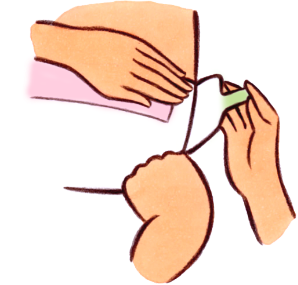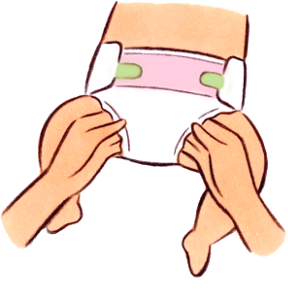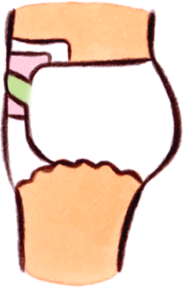- Top
- Diaper Guide
- How to Prevent Leakage from Tape Diapers

How to Prevent Leakage from Tape Diapers
The most common cause of leakage is fitting your baby with the wrong diaper size. So start by checking if the diaper size is right for your baby. Note also that the amount of pee increases as your baby grows. By the time your baby is 12 months old, the amount of pee discharged in a day will be twice that of a newborn. While the diaper size may appear to fit your baby, the amount of pee may have increased with his growth, so the diaper may not be able to absorb the larger amount of urine. For disposable diapers, the bigger the size, the better the absorbency. If you notice frequent leakages, it may be time to change the diaper to a larger size.
If there is leakage even though you have fitted the diaper properly on your baby, do a check for the following:
- Are the leg gathers folded inwards?
- Are the diaper tapes around the tummy fastened properly?
- Are there any gaps between the diaper and baby's thighs?

Why is baby's diaper leaking?
Advice for leakages from different parts of the diaper
Advice for leakages from different parts of the diaper
1. Back leakage
Causes
- Gap between diaper and baby's back.
- Diaper tends to go out of alignment due to the baby's active leg movements. (Fairly common for S size users).
- Diaper is taped more to the front, leaving less coverage for the back.
Advice
When placing the diaper under baby's bottom, make sure you pull the diaper high enough to prevent leakage. Raise the back portion slightly higher than the front portion and then fasten the tape diagonally downwards.

2. Side leakage
Causes
-
The gathers around the legs may be folded inwards.
-
The position of the tape fastened is out of the marked area.
-
The tape has not been fastened evenly at both sides.
Advice
Make sure that the diaper edges are not folded and that the tape is fastened evenly. If you notice that the position where you fasten the tape is out of the marked area, it's time to change the size of the diaper. Try using one size bigger.

3. Thigh leakage
Causes
-
Leg gathers are folded inwards.
- There are gaps around the thighs. (A gap is likely to appear between babies' thighs and the diaper as their legs are spread out when they are fastened into child seats or strollers.)
Advice
Pull the diaper straight and high enough to reach the belly button area. Adjust the gathers around the leg area so that they fit properly around the crotch area. Make sure the gathers are pulled outwards. If the leakage continues even after your child has been strapped on with a seat belt, try to fasten the diaper tape at a lower level, slightly slanted at an angle.

4. Tummy leakage
Causes
-
Diaper is too loose-fitting around the waist.
-
When baby is lying on his tummy, pee tends to flow up towards baby's tummy.
-
(In the case of boys) The penis is pointing upwards.
Advice
Raise the front portion of the diaper slightly higher than the back portion and fasten the tape slanting upwards so that the belly button is hidden. For boys, make sure the penis is pointing downwards.

- Top
- Diaper Guide
- How to Prevent Leakage from Tape Diapers



